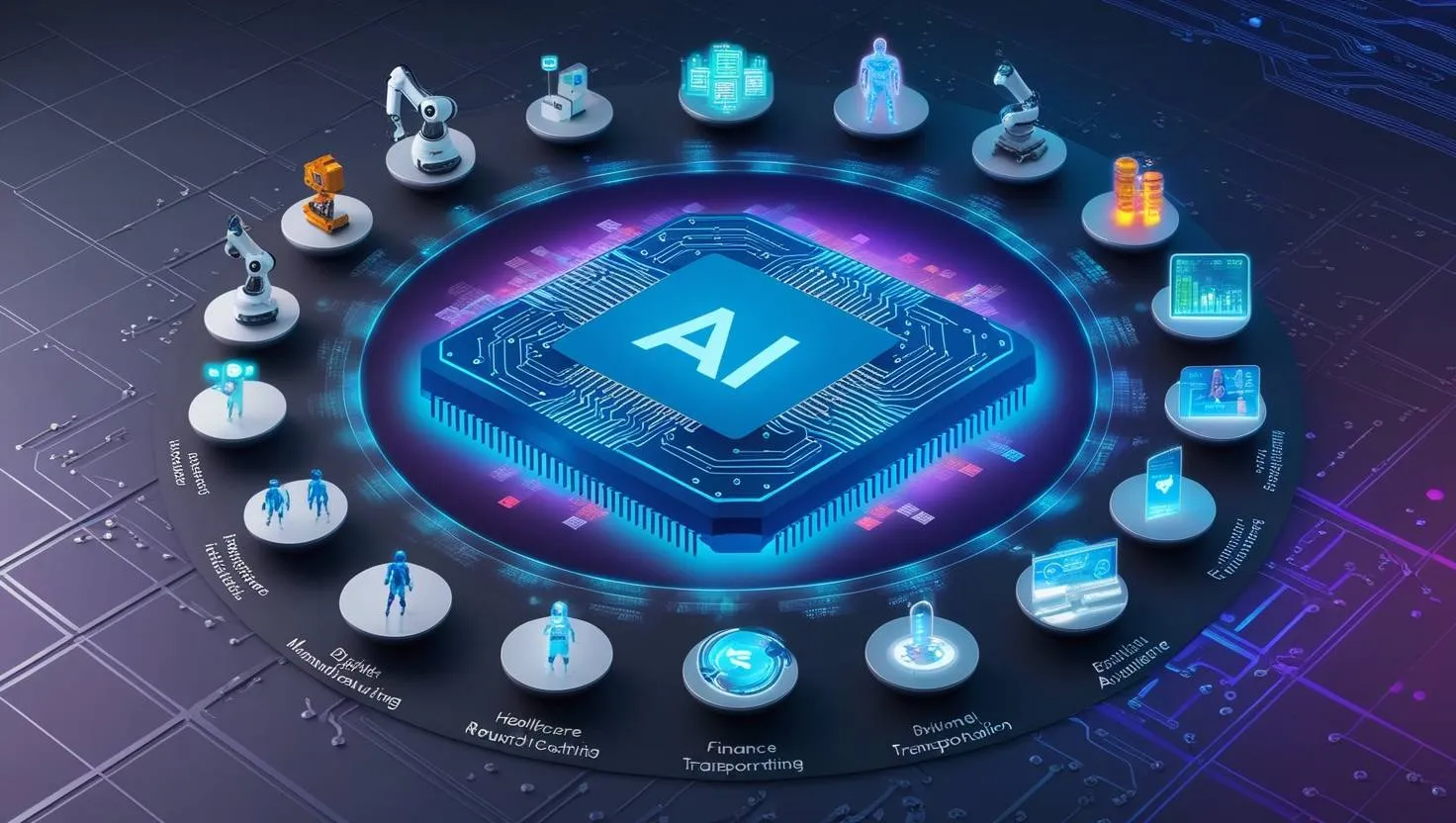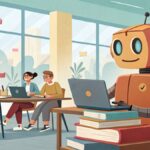Once the stuff of science fiction, artificial intelligence (AI) has rapidly evolved into a powerful tool, driving innovation across key sectors. From enhancing medical diagnostics to streamlining supply chains, AI’s journey from concept to practical application is nothing short of revolutionary.
With AI’s increasing integration into everyday processes, industries are experiencing a transformation that extends beyond initial excitement to tangible benefits and efficiencies.
This article explores AI trends that are more than just hype; they are actively reshaping industries across the globe and paving the way for future advancements.
1. AI in Healthcare
AI in Healthcare is revolutionizing the way we diagnose, treat, and manage health conditions, offering exciting possibilities for both practitioners and patients. Let’s dive deeper into how AI is transforming this critical industry.
AI-Powered Diagnostics
AI is setting new standards in diagnostic accuracy and speed. Take radiology, for example—AI algorithms are now capable of analyzing medical images to detect cancerous tumors with a precision that often surpasses human capabilities. This technology not only speeds up the diagnostic process but also enhances early detection rates, which is crucial for successful treatment outcomes. Companies like Aidoc and Zebra Medical Vision are at the forefront, using AI to assist radiologists in identifying abnormalities quickly and efficiently.
Robotic Surgeries and AI-Assisted Procedures
When it comes to surgery, AI-powered robotic systems are game-changers. These systems offer surgeons enhanced control and precision, resulting in minimally invasive procedures that can significantly reduce recovery times for patients. The da Vinci Surgical System is a prime example, providing surgeons with a magnified, 3D high-definition view of the surgical site and enabling precise movements that are difficult to achieve with human hands alone. This technology not only improves success rates but also minimizes the risk of complications.
AI in Drug Discovery and Research Acceleration
The drug discovery process has traditionally been long and costly, but AI is changing that narrative. By sifting through vast amounts of data, AI can identify potential drug candidates at a fraction of the time and cost.
Companies like Atomwise and BenevolentAI are leveraging AI to predict how different compounds will interact with the human body, accelerating the development of new medications. This approach not only speeds up the time it takes to bring drugs to market but also opens up new possibilities for personalized medicine tailored to individual genetic profiles.
Telemedicine and Patient Data Analytics
AI is making healthcare more accessible through advancements in telemedicine and patient data analytics. AI-driven platforms enable healthcare providers to conduct remote consultations and monitor patient health in real time. This is especially beneficial in underserved regions where access to healthcare facilities is limited.
For instance, platforms like Teladoc and Amwell use AI to analyze patient data, offering insights that can help in managing chronic conditions and predicting health trends. As technology advances, we can expect AI to play an even larger role in personalized healthcare, providing patients with tailored advice and treatment plans based on comprehensive data analysis.
Real-World Examples and Future Developments
The potential future developments in AI healthcare applications are vast. AI could soon be used to predict disease outbreaks by analyzing social media trends and travel data or to assist in mental health by offering real-time mood analysis and support. As AI technology continues to evolve, its integration into healthcare promises to not only improve efficiency and outcomes but also to make advanced medical care accessible to populations across the globe.
In summary, AI in healthcare is not just about technological advancement—it’s about improving the quality and accessibility of care, ensuring that patients receive timely and accurate diagnoses, effective treatments, and continuous support, no matter where they are. As we look to the future, AI’s role in healthcare will undoubtedly expand, bringing new innovations and challenges to the forefront.
2. AI in Finance
AI in Finance is rapidly transforming the industry, offering new efficiencies and capabilities that were once unimaginable. Let’s explore the profound ways AI is reshaping financial services.
Algorithmic Trading and Predictive Analytics
AI has revolutionized trading strategies through algorithmic trading and predictive analytics. By automating complex strategies, AI optimizes investment decisions, processing vast amounts of market data in real time to identify trends and opportunities that human traders might miss.
For example, firms like Renaissance Technologies and Two Sigma leverage AI to execute trades at lightning speed, maximizing returns while minimizing risk. Predictive analytics tools forecast market movements with remarkable precision, helping investors make informed decisions grounded in data-driven insights.
Fraud Detection and Cybersecurity Advancements
In the realm of security, AI is a formidable ally in fraud detection and cybersecurity. AI systems are designed to continuously monitor financial transactions, detecting anomalies and suspicious patterns that could indicate fraudulent activity. This proactive approach significantly reduces financial losses by preventing fraud before it occurs.
Companies like PayPal and Mastercard utilize AI to enhance security measures, ensuring customer transactions are safe and secure. As cyber threats evolve, AI’s ability to adapt and learn from new data makes it an essential component of modern cybersecurity strategies.
AI-Driven Customer Service
Customer service in banking has been enhanced significantly through AI-driven tools like chatbots and virtual assistants. These technologies provide customers with immediate support, answering queries and resolving issues around the clock.
Banks such as Bank of America with its virtual assistant Erica, and Capital One with Eno, offer personalized services that enhance user experiences. These AI systems learn from interactions, refining their responses to better meet customer needs, reducing wait times, and freeing human agents to handle more complex inquiries.
Personalized Financial Planning with AI Algorithms
AI algorithms are also redefining personalized financial planning. By analyzing individual financial behaviors and preferences, AI delivers tailored financial advice, empowering users to make informed decisions about their finances.
Platforms like Betterment and Wealthfront use AI to guide investment strategies based on personal goals and risk appetites. This level of personalization was once reserved for high-net-worth individuals but is now accessible to a broader audience, democratizing financial planning.
Real-World Examples and Future Developments
The future of AI in finance is teeming with possibilities. AI’s role in risk management is expanding, with systems capable of predicting economic downturns and advising on risk mitigation strategies.
Additionally, AI is poised to revolutionize the loan approval process, assessing creditworthiness with greater accuracy by analyzing alternative data sources such as social media activity and electronic transaction history. As AI continues to evolve, we can expect even more innovative applications that will enhance the accuracy, efficiency, and accessibility of financial services across the globe.
In conclusion, AI in finance is not just about adopting new technology—it’s about transforming the very fabric of financial services to deliver smarter, more secure, and highly personalized experiences for customers. As advancements continue, the potential for AI to drive innovation and growth in the financial sector is boundless.
3. AI in Manufacturing
AI in Manufacturing is driving a new era of efficiency and innovation, fundamentally changing how products are made, distributed, and maintained. Let’s explore how AI is powering this transformation.
Smart Factories and IoT Integration
In the world of smart factories, AI plays a crucial role by integrating with the Internet of Things (IoT) to connect various devices and systems. This connectivity enables seamless operations and proactive maintenance, transforming traditional manufacturing processes into highly efficient systems.
For instance, companies like Siemens and General Electric utilize AI-driven IoT solutions to monitor equipment health in real-time, allowing for swift response to potential issues before they escalate into costly disruptions. This integration not only enhances production efficiency but also ensures that factories can adapt quickly to changes in demand or production requirements.
Predictive Maintenance and Downtime Prevention
AI’s predictive capabilities are a game-changer in maintenance strategies. By analyzing vast amounts of machinery data, AI algorithms can predict potential equipment failures before they occur, significantly reducing downtime and maintenance costs. This approach, employed by leaders like Caterpillar and Bosch, minimizes unexpected breakdowns and extends the operational lifespan of machinery.
Predictive maintenance not only saves time and money but also boosts productivity by ensuring machinery is always running at optimal performance levels.
AI-Powered Supply Chain Optimization
The supply chain is the backbone of manufacturing, and AI is making it more resilient and efficient. Through advanced demand forecasting and resource allocation, AI helps manufacturers anticipate market needs and allocate resources accordingly.
Companies such as Amazon and Procter & Gamble leverage AI to optimize logistics, reduce waste, and improve delivery times. This technology enables a more agile supply chain that can quickly respond to changes and disruptions, ensuring products reach consumers faster and with fewer hiccups.
Robotics in Production Lines: Efficiency and Precision
AI-driven robotics are at the forefront of modern production lines, providing unmatched efficiency and precision. These robotic systems are capable of performing repetitive tasks with consistent quality, reducing human error and increasing productivity. Tesla and Foxconn are prime examples of companies using AI-powered robotics to streamline their production processes. As a result, these companies can achieve higher output levels while maintaining high standards of quality and safety.
Real-World Examples and Future Developments
Looking ahead, AI in manufacturing is set to evolve even further, with advancements such as autonomous mobile robots and AI-driven quality control systems. These innovations promise to enhance production flexibility, reduce human intervention, and improve product quality. For example, autonomous robots could navigate factory floors independently, transporting materials and products with greater efficiency.
As AI continues to evolve, manufacturers can expect to see even more groundbreaking applications that will redefine production capabilities and set new standards for industry performance.
In summary, AI in manufacturing is not just about adopting new technologies—it’s about creating smarter, more adaptive, and more efficient manufacturing processes. As AI continues to advance, the potential for innovation and growth in the manufacturing sector is limitless, paving the way for a future where factories operate seamlessly, supply chains are resilient, and production lines are more efficient than ever before.
4. AI in Retail and E-commerce
AI in Retail and E-commerce is revolutionizing the way consumers shop and businesses operate, offering personalized experiences and optimized logistics. Let’s dive into how AI is reshaping this industry.
Personalization of the Shopping Experience through AI
AI is at the forefront of personalizing shopping experiences by analyzing vast amounts of customer data to offer tailored product recommendations. This customization not only boosts sales but also enhances customer satisfaction by providing shoppers with products they are most likely to purchase.
For example, Amazon’s recommendation engine suggests products based on past purchases and browsing history, creating a personalized shopping journey for each customer. As AI continues to advance, retailers can expect even more sophisticated personalization, such as dynamic pricing and real-time promotions targeted to individual customer’s preferences.
Inventory Management and Logistics Powered by AI-Driven Demand Forecasting
Efficient inventory management is critical for retail success, and AI is a game-changer in this aspect. By employing AI-driven demand forecasting, retailers can predict trends, optimize stock levels, and reduce waste. This means fewer out-of-stock scenarios and reduced overstock, which directly translates to cost savings and improved customer satisfaction.
Companies like Walmart use AI to analyze purchasing patterns and external factors such as weather and local events to adjust inventory levels accordingly. In the future, AI could integrate even more data sources, like real-time social media trends, to fine-tune its predictions further.
AI in Marketing Automation and Customer Service
In the realm of marketing and customer service, AI is enhancing engagement through automation. Automated marketing campaigns utilize AI to analyze customer data and send personalized content that resonates with each individual.
AI-powered chatbots provide instant customer support, answering queries, and resolving issues around the clock, which improves the overall customer experience.
Sephora, for instance, uses chatbots to offer beauty tips and product recommendations, ensuring customer interaction is both informative and engaging. As AI evolves, these chatbots are expected to become even more intuitive, handling complex customer inquiries with ease.
Augmented Reality (AR) Shopping Experiences
AI is also making waves with augmented reality (AR), bridging the gap between online and in-store shopping. Virtual try-ons and immersive shopping experiences allow customers to visualize products in their environment before making a purchase.
This technology is particularly popular in fashion and home decor, where companies like IKEA and Warby Parker offer AR apps for customers to try furniture or eyeglasses virtually. As AR technology becomes more sophisticated, we can anticipate more retailers adopting these tools to offer a seamless and interactive shopping experience that merges the physical and digital worlds.
Real-World Examples and Future Developments
Looking ahead, AI in retail and e-commerce will likely continue to evolve, introducing innovations such as hyper-personalized shopping assistants and AI-driven visual search capabilities. These advancements promise to enhance customer experience by offering more intuitive and interactive ways to shop. Retailers that embrace these technologies will not only improve their operational efficiency but also gain a competitive edge by delivering superior customer experiences.
In summary, AI in retail and e-commerce is about more than just technological advancements—it’s a complete transformation of how businesses interact with consumers. As AI continues to evolve, the potential for enhancing personalization, efficiency, and customer satisfaction in the retail sector is limitless, paving the way for a more connected and engaging shopping experience.
5. AI in Transportation and Logistics
AI in Transportation and Logistics is driving remarkable innovation, transforming how goods and people move around the globe. Let’s delve into how AI is revolutionizing this vital industry.
Autonomous Vehicles
Once a science fiction concept, autonomous vehicles are now on the cusp of becoming a reality, thanks to breakthroughs in AI technology. AI is essential in enabling these vehicles to navigate safely by processing vast amounts of data from sensors and cameras to understand their environment, make decisions, and respond to dynamic road conditions.
Companies like Waymo and Tesla are at the forefront, conducting rigorous testing to ensure these vehicles can safely and efficiently operate in diverse settings. As testing progresses, the potential for autonomous vehicles to reduce traffic congestion, lower emissions, and enhance road safety becomes increasingly feasible.
AI in Route Optimization and Fleet Management
AI’s ability to analyze traffic patterns and logistical data is revolutionizing route optimization and fleet management. By predicting traffic conditions and identifying the most efficient routes, AI helps reduce delivery times and costs.
Firms like UPS and DHL harness AI to streamline their delivery processes, ensuring timely arrivals and maximizing fuel efficiency. This technology not only improves operational efficiency but also enhances customer satisfaction by providing more accurate delivery windows. As AI technology advances, we can expect even more sophisticated systems capable of adapting to real-time changes in conditions, further optimizing logistics operations.
Drone Deliveries and Last-Mile Logistics
AI-powered drones are pioneering last-mile delivery solutions, promising quicker and more efficient services, especially in areas hard to access by traditional means. These drones use AI to navigate complex environments, identify delivery locations, and avoid obstacles.
Companies like Amazon and Zipline are leading the charge, with Amazon trialing drone deliveries in suburban areas and Zipline using drones to deliver medical supplies to remote regions. As drone technology and AI algorithms advance, we can anticipate a significant expansion in their use, potentially reshaping our understanding of logistics and delivery services.
AI’s Role in Improving Supply Chain Efficiency
AI is pivotal in enhancing supply chain efficiency by streamlining processes and reducing bottlenecks. By leveraging AI to analyze data across the supply chain, organizations can identify inefficiencies, predict demand fluctuations, and optimize inventory levels. This capability leads to a more resilient supply chain that can quickly adapt to changes and disruptions.
Companies like IBM and Maersk are deploying AI solutions to enhance their supply chain operations, ensuring smooth and efficient logistics management. As AI continues to develop, its application in supply chain management will likely expand, offering even greater improvements in efficiency and responsiveness.
Real-World Examples and Future Developments
Looking to the future, AI in transportation and logistics is poised to embrace innovations such as hyper-automated warehouses and AI-driven traffic management systems. These advancements promise to further enhance efficiency and safety in logistics and transportation networks. As companies continue to invest in AI technologies, the potential for creating a seamless and efficient transportation system is vast, offering exciting possibilities for the future of global logistics.
In summary, AI is not just improving transportation and logistics—it’s redefining how these industries operate. With ongoing advancements, the potential for AI to revolutionize transportation and logistics, making them more efficient, safe, and sustainable, is boundless.
6. AI in Education
AI in Education is transforming the learning landscape, offering new possibilities for personalized and efficient educational experiences. Let’s explore how AI is making waves in this critical sector.
Adaptive Learning Systems and Personalized Education
AI-powered adaptive learning systems are revolutionizing education by personalizing content to match individual students’ learning rates and styles. These systems analyze data on student performance and preferences, adjusting materials and instructional methods accordingly. This personalized approach enhances student engagement and outcomes by ensuring that each learner receives content that meets their unique needs.
Platforms like DreamBox and Smart Sparrow utilize AI to create tailored learning experiences, helping students grasp complex concepts at their own pace. As AI technology continues to evolve, we can expect these systems to offer even more precise and effective personalization.
AI in Grading and Administrative Automation
AI is streamlining grading and administrative tasks, freeing educators to focus on teaching and student interaction. Automated grading systems can quickly and accurately assess assignments, providing instant feedback to students. This reduces the administrative burden on teachers, allowing them to dedicate more time to developing engaging lesson plans and supporting students.
Tools like Gradescope are already in use, leveraging AI to grade assignments and exams efficiently. As AI capabilities improve, these systems will likely become more sophisticated, handling a wider range of tasks and further enhancing educational efficiency.
AI-Driven Tutoring Systems
AI-driven tutoring systems offer personalized support to help students overcome learning challenges. These systems use AI to analyze student performance and provide tailored guidance, helping learners master difficult subjects. By offering targeted assistance, AI tutors can address specific areas where students struggle, improving their overall understanding and confidence.
Companies like Carnegie Learning and Squirrel AI are pioneering AI-driven tutoring solutions, offering personalized experiences that adapt to each student’s needs. As these systems advance, they are expected to become even more intuitive and responsive, providing increasingly effective educational support.
Challenges and Ethical Considerations
As AI adoption in education grows, it is crucial to address challenges and ethical considerations, such as data privacy and the digital divide. Ensuring that student data is protected and used responsibly is paramount to maintaining trust and security.
Additionally, there is a need to address the digital divide, ensuring that all students have equitable access to AI-powered educational tools. Policymakers and educators must work together to develop guidelines and solutions that promote fair and inclusive AI use in education. As these issues are addressed, the potential for AI to enhance educational equity and access will become more apparent.
Real-World Examples and Future Developments
Real-world examples of AI in education, such as Coursera’s personalized course recommendations and Duolingo’s adaptive language learning, demonstrate the technology’s potential to transform learning. Looking ahead, we can anticipate further developments in AI education applications, such as more advanced virtual classrooms and AI-driven curriculum design. These innovations promise to make education more accessible, engaging, and effective for learners worldwide.
In summary, AI is not just an enhancement to education—it’s a transformative force reshaping how we learn and teach. With ongoing advancements, AI’s potential to revolutionize education by making it more personalized, efficient, and accessible is immense, paving the way for a brighter future for learners everywhere.
7. AI in Entertainment and Media
AI in Entertainment and Media is unlocking new creative horizons and enhancing user experiences in unprecedented ways. Let’s delve into how AI is reshaping this vibrant industry.
Content Creation and Curation through AI
AI is revolutionizing content creation by assisting in the production of written content, music, and art, thereby expanding creative possibilities. AI algorithms can generate articles, compose music, and even create visual art, allowing creators to explore new artistic avenues and produce work more efficiently.
For example, OpenAI’s GPT models can draft text, while tools like AIVA generate music tailored to specific moods or themes. As AI technologies continue to evolve, artists and creators can leverage these tools to push the boundaries of creativity and streamline production processes, ultimately enhancing both quality and efficiency.
AI-Powered Recommendation Engines
The entertainment industry relies heavily on AI-powered recommendation engines to personalize user experiences. Platforms like Netflix and Spotify employ sophisticated AI algorithms to analyze user preferences and viewing habits, suggesting content that aligns with individual tastes.
This personalized approach not only improves user satisfaction by delivering relevant content but also increases engagement and retention. As AI recommendation systems become more advanced, they promise to further refine their ability to predict user preferences, offering an even more tailored and immersive entertainment experience.
Deepfakes and AI-Generated Media
AI has introduced powerful tools for media creation, such as deepfakes, which can simulate realistic images, videos, or audio of individuals. While these technologies offer innovative possibilities in film and media production, they also raise ethical concerns regarding potential misuse.
The rise of deepfakes underscores the need for robust ethical guidelines and regulations to ensure these tools are used responsibly, protecting individuals from identity theft and misinformation. As the industry grapples with these challenges, developing frameworks to manage and mitigate the risks associated with AI-generated media will be crucial.
AI for Film Editing and Production Efficiency
In the realm of filmmaking, AI streamlines editing and production processes, enabling filmmakers to focus on creative aspects rather than routine tasks. AI tools can automate tasks such as scene selection, color correction, and even script analysis, significantly reducing the time and effort required in post-production.
Companies like Adobe and Magisto are pioneering AI-driven editing software that enhances production efficiency. As AI technologies advance, we can expect these tools to become even more sophisticated, offering filmmakers unprecedented creative freedom and efficiency.
Real-World Examples and Future Developments
Real-world examples of AI in entertainment include Warner Music Group’s use of AI to scout new talent and Sony’s AI-driven music composition tools. Looking ahead, we anticipate further advancements in AI applications, such as more immersive virtual reality experiences and AI-generated interactive narratives. These innovations promise to transform how we consume and engage with media, offering richer, more personalized experiences.
In summary, AI in entertainment and media is more than just a set of tools—it’s a catalyst for innovation, reshaping how creators produce content and how audiences experience it. With ongoing advancements, AI’s potential to redefine creativity and enhance user engagement in the entertainment industry is vast, paving the way for a dynamic and exciting future.
8. AI in Agriculture
AI in Agriculture is transforming traditional farming methods, offering innovative solutions for increased efficiency and sustainability. Let’s explore how AI is reshaping this vital industry.
Precision Farming
AI plays a crucial role in precision farming by analyzing massive datasets for crop monitoring, optimizing yields, and minimizing resource usage. By utilizing AI-powered tools like drones and sensors, farmers can gather real-time data on soil conditions, weather patterns, and crop health. This information allows for precise application of water, fertilizers, and pesticides, leading to healthier crops and increased productivity.
For instance, companies like John Deere are integrating AI into their equipment to provide farmers with actionable insights, enhancing decision-making and reducing waste. As AI technology advances, precision farming will become even more refined, helping farmers sustainably maximize their outputs.
AI in Pest and Disease Detection
AI is revolutionizing pest and disease management through early detection systems that help minimize crop losses. Machine learning algorithms can analyze images of plants to identify signs of disease or pest infestations before they become widespread. By catching these issues early, farmers can implement targeted interventions, reducing the need for broad-spectrum pesticides and preserving crop health.
Platforms like Plantix use AI to diagnose plant diseases from smartphone photos, offering farmers instant, actionable advice. As these systems become more sophisticated, they will provide even greater support in maintaining crop health and productivity.
Automation in Harvesting and Food Production
AI-driven machines are automating labor-intensive tasks in harvesting and food production, significantly increasing efficiency and reducing labor costs. Robotic harvesters equipped with AI technology can pick fruits and vegetables more quickly and accurately than human workers, ensuring consistent quality and reducing food waste.
Companies such as Harvest CROO Robotics are developing autonomous machines capable of performing complex agricultural tasks. As AI continues to evolve, automation will play an even larger role in agriculture, freeing up human labor for more strategic roles and enhancing overall production efficiency.
AI’s Role in Sustainable Agriculture Practices
AI contributes significantly to sustainable agriculture by optimizing resource use and promoting environmental conservation. By precisely managing inputs like water and fertilizers, AI helps reduce the environmental impact of farming operations. Additionally, AI tools can assist in monitoring biodiversity and soil health, supporting practices that maintain ecological balance.
For example, Blue River Technology uses AI to selectively apply herbicides, minimizing chemical usage and protecting surrounding ecosystems. As sustainable farming becomes increasingly important, AI’s role in promoting environmentally friendly practices will continue to expand.
Real-World Examples and Future Developments
In practice, AI applications in agriculture are already demonstrating significant benefits. For instance, IBM’s Watson Decision Platform for Agriculture provides a comprehensive suite of AI tools that assist farmers in making informed decisions about their crops. Looking to the future, we can expect further advancements in AI agriculture applications, such as more sophisticated predictive analytics for climate adaptation and advanced robotics for complex farming tasks. These innovations promise to drive agriculture toward a more sustainable and productive future.
In conclusion, AI in agriculture is not just enhancing farming practices—it’s a transformative force leading the industry towards greater efficiency, sustainability, and resilience. With ongoing advancements, AI’s potential to revolutionize agriculture is immense, paving the way for a more sustainable and food-secure world.
9. The Future of AI: What’s Next?
The future of AI is a rapidly evolving landscape, brimming with potential and challenges that promise to redefine how we live and work. Let’s delve into the emerging trends, challenges, and industry transformations that AI is set to bring.
Emerging AI Trends to Watch
One of the most anticipated developments in AI is the integration of quantum computing. This technology holds the promise of exponentially enhancing AI’s computational abilities, enabling it to handle complex problems that are currently beyond reach.
Quantum computing could revolutionize areas such as drug discovery, cryptography, and climate modeling by processing vast datasets with unprecedented speed and accuracy. Additionally, the movement toward ethical AI is gaining momentum, focusing on creating algorithms that are transparent, fair, and accountable.
Ensuring that AI systems operate without bias and respect human rights is crucial as these technologies become more embedded in our daily lives.
Human-AI collaboration is another key trend, emphasizing the development of AI tools that enhance human capabilities rather than replace them. By designing AI to work alongside humans, we can unlock new levels of productivity and creativity across various fields.
Potential Challenges
As AI continues to advance, several challenges must be addressed. Data privacy remains a paramount concern, as AI systems require vast amounts of data to function effectively. Protecting personal information and ensuring secure data handling are essential to maintaining public trust. Job displacement is another critical issue, with AI automating tasks that were once performed by humans.
While AI creates new opportunities, there is a pressing need for policies that support workforce retraining and adaptation. Establishing regulatory frameworks is also vital to navigating the ethical and societal implications of AI. Governments and organizations must collaborate to create guidelines that balance innovation with public safety and welfare.
How AI Will Continue to Shape Industries
Over the next decade, AI is poised to drive significant innovation across industries, creating new opportunities and reshaping existing paradigms. In healthcare, AI could transform patient care through advanced diagnostics, personalized treatment plans, and robotic surgery.
In finance, AI-powered algorithms are set to enhance fraud detection, risk management, and customer service. The retail industry will see more sophisticated AI applications in supply chain management and personalized customer experiences.
Real-world examples of AI’s transformative power include autonomous vehicles revolutionizing transportation, and AI-driven chatbots enhancing customer interactions in e-commerce. As AI technology matures, its integration into various sectors will likely accelerate, fostering a dynamic environment where businesses and individuals can thrive.
Looking ahead, the potential for AI to revolutionize our world is immense. By navigating its challenges and harnessing its capabilities, we can pave the way for a future where AI not only enhances our lives but also contributes to a more equitable and sustainable society. As we stand on the brink of this new era, the possibilities are as exciting as they are vast, promising a future where AI’s full potential is realized.
Conclusion
AI is fundamentally reshaping the landscape of industries across the board, driving profound transformations in how businesses operate, innovate, and serve their markets. From revolutionizing transportation and logistics to personalizing education and enhancing media experiences, AI’s influence is both expansive and deep. It’s not just about the initial buzz; AI stands as a pivotal force in advancing efficiency and sparking innovation in real-world scenarios.
As we look to the future, the potential for AI to continue this trajectory of growth and impact is immense. Embracing AI means leveraging its capabilities to drive success and foster growth across industries, while also thoughtfully addressing challenges such as data privacy, ethical considerations, and workforce adaptation. By doing so, businesses can unlock unprecedented opportunities and usher in a new era of technological advancement.
We invite you to join the conversation—share your thoughts and experiences with AI in the comments. Whether you’re an industry veteran or a curious newcomer, your insights can help build a community of shared learning, fostering a deeper understanding of AI’s role in shaping our future. Let’s explore these possibilities together and harness the power of AI for a better tomorrow.
Frequently Asked Questions about AI Trends
What are the emerging trends in AI technology?
AI is rapidly evolving, with trends like quantum computing, which promises to vastly increase computational power, and the growing focus on ethical AI, ensuring that technologies are fair and transparent. Human-AI collaboration is also gaining traction, aiming to enhance human capabilities rather than replace them.
How is AI impacting industries today?
AI is transforming industries by improving efficiency, personalizing customer experiences, and driving innovation. In healthcare, for instance, AI aids in diagnostics and treatment planning, while in finance, it’s used for risk management and fraud detection.
What are the ethical considerations surrounding AI?
Ethical AI involves creating unbiased systems, respecting user privacy, and being transparent in their decision-making processes. As AI becomes more integrated into society, ensuring these ethical norms are upheld is crucial to maintaining public trust.
What challenges does the advancement of AI present?
Key challenges include data privacy concerns, job displacement due to automation, and the need for robust regulatory frameworks. Addressing these issues is essential to harnessing AI’s full potential while minimizing negative impacts.
How will quantum computing affect AI development?
Quantum computing is expected to revolutionize AI by enabling complex problem-solving at speeds unattainable by classical computers. This could lead to breakthroughs in fields like drug discovery, cryptography, and climate modeling.
What role does AI play in sustainability efforts?
AI aids sustainability by optimizing resource use in industries like agriculture and manufacturing, reducing waste, and improving energy efficiency. It can also contribute to environmental conservation through smarter urban planning and energy management systems.
How is AI expected to shape the future of work?
AI is likely to change the nature of work, automating routine tasks and creating new roles focused on oversight and collaboration with AI systems. Workforce retraining and adaptation will be key to navigating this shift.
What industries are most impacted by AI innovations?
While AI is influencing nearly all sectors, industries like healthcare, finance, retail, and transportation are experiencing significant transformation. Each is leveraging AI to improve services, reduce costs, and enhance customer engagement.
How can businesses prepare for the future of AI?
Businesses should focus on integrating AI into their operations, investing in employee training, and staying informed about technological advancements and ethical considerations to harness AI’s full benefits.
How can individuals contribute to the ethical development of AI?
Individuals can advocate for transparency and fairness in AI systems, participate in public discourse on AI ethics, and support organizations that prioritize ethical AI development. Sharing personal experiences and insights can also help shape a more equitable AI future.





















